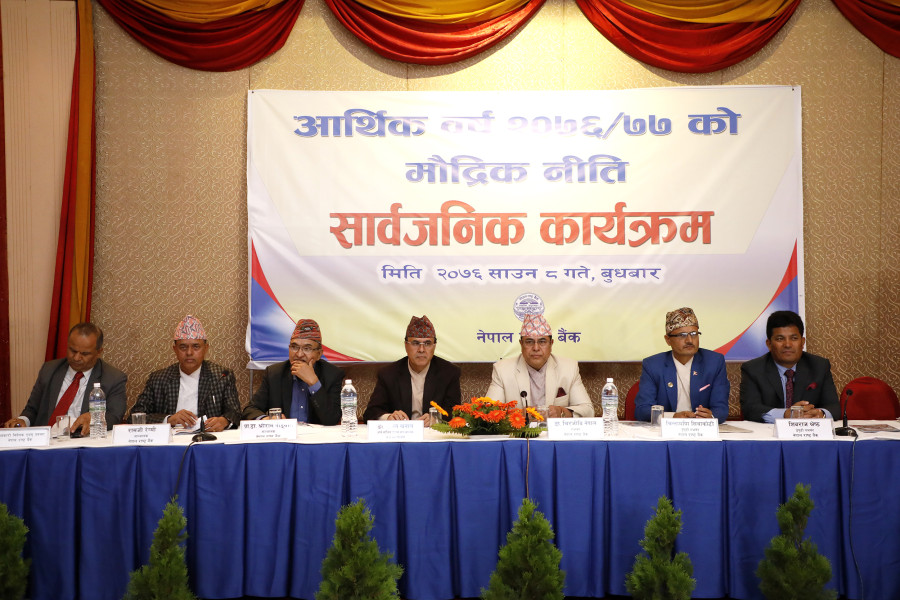Columns
Monetary policy is no great shakes
Observers had thought there would be something in the document to revive the stock market and strengthen the banking sector.
Jagadish Prasad Bist
Everyone seems to have been looking forward to the Monetary Policy 2019-20 with great anticipation. Share investors have been waiting for the policy to breathe life into the Nepal Stock Exchange, bankers have been waiting to draw a trajectory of the future of their banks, and economists have been waiting to see how the monetary policy will address the government's highly ambitious plans. Nepal Rastra Bank finally unveiled the policy, and its highlights include issuing debentures worth at least 25 percent of the paid-up capital of commercial banks, collecting permanent account number (PAN) for loans worth at least Rs5 million, and allocating at least 10 and 15 percent of the loans to the agriculture and tourism sectors respectively.
The provision making gold a depositable asset is a new initiative of the monetary policy. In addition, the central bank has tried to manage liquidity in the market by allowing banks and financial institutions to collect funds from abroad. The policy has aimed to keep inflation below 6 percent and support the government in achieving a growth target of 8.5 percent.
Much trumpeted term
The much trumpeted term 'forceful big merger' did not make it into the monetary policy. Rather, the policy has tried to promote mergers and acquisitions among banks by offering a number of incentives. The central bank has set the minimum cap on loans to the agriculture, tourism and energy sectors, and deferred the required aggregate spread rate. Banks going for merger will not need the central bank's permission to open new branches, and high level executives will not be subject to the six-month waiting period before joining other institutions.
What can be understood from the current policy is that Nepal Rastra Bank does not want to push banks into mergers and acquisitions. The objective of the central bank and the government to reduce the number of banks and increase their lending and risk absorbing capacity is not going to be fulfilled with such policies. Without increasing the paid-up capital and forcing banks to go for mergers and acquisitions, the well-established CEOs of Nepali banks will not agree to do so.
Therefore, since the banking system is going to be the same this fiscal year as it has been in the past, the entrenched problems of liquidity and unhealthy competition in interest rates are also going to remain. Hence the stock market is going to suffer more. What is a much worrying issue is that talk of potential big mergers had excited the stock market, and it was being seen as something that would make the NEPSE index shoot up. But now the situation has changed, and it will not be surprising if the stock market starts going downhill in response to the policy.
Considering that banking institutions have been hardly able to sell their stocks in the market nowadays, the obligatory debenture issue is going to be a further nightmare for them. Due to the high volatility in interest rates and low return on debentures, potential investors have already started turning away from such securities. More importantly, the point that has to be noted here is the contradiction between two of the objectives of the current monetary policy: curbing interest rates and issuing debentures. Nepal Rastra Bank has been trying to reduce interest rates by slashing the interbank credit rate; but at the same time, it is also forcing banks to issue debentures.
Passed up a golden chance
But the current scenario is that despite offering a competitive coupon rate of above 10 percent, banks are hardly able to sell their bonds. And if they are compelled to issue such unpopular debentures, it is going to infest the market with bonds worth at least Rs56 billion (computed on the basis of a minimum paid-up capital of Rs8 billion and 28 commercial banks). An influx in supply and a downturn in demand for such bonds is going to force banks to propose high interest rates, increasing the cost of capital. What the current policy has missed is addressing the rudimentary banking system in Nepal. The central bank passed up a golden chance to force banks to go for mergers and acquisitions and increase both their lending and risk absorbing capacity. If this is not the time, when the bankers themselves have started looking for prospective partners for mergers, there will never be another time.
What is to be understood is that it is not about policy, it is about how the system has been developed. The same is likely to apply in the case of debenture issue: Given the poor performance of shares in the market, debentures are likely to worsen the situation. Thus, the current need is not policies that are applied in the developed banking systems, but the rejuvenation of the banking system itself. A fragile banking system like that in Nepal, where there are a large number of banks with low capacity, responds negatively to even good initiatives from the regulator.
***
What do you think?
Dear reader, we’d like to hear from you. We regularly publish letters to the editor on contemporary issues or direct responses to something the Post has recently published. Please send your letters to [email protected] with "Letter to the Editor" in the subject line. Please include your name, location, and a contact address so one of our editors can reach out to you.




 19.68°C Kathmandu
19.68°C Kathmandu.jpg)














